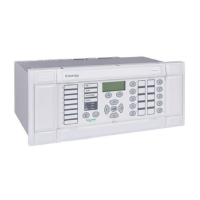Operation P54x/EN OP/La4
MiCOM P543, P544, P545 & P546
(OP) 5-113
OP
The MiCOM P591 communications interface units do not require any special setting up and
the communications should be now configured.
2.1.13 Protection communications scheme set-up
The S
cheme Set-up setting selects the connection between the system ends. A two ended
system may have a single communication channel between the ends (2 Terminal option) or
two independent communication channels to achieve dual redundancy (Dual Redundant
option). A three ended system is selected by the option 3 Terminal.
2.1.14 Dual redundant (“hot standby”)
If one of the cha
nnels has failed, the communication between the relays can still be
maintained by the other healthy channel.
The dual redundant model provides redundancy for communication channels by transmitting
and receiving messages over both channels. Each channel is monitored continuously by the
relay. The messages from both channels are used to perform the relay functions. If only
one channel is available, the messages from this healthy channel are used to perform the
relay functions.
The messages are transmitted over the 2 channels alternately. Every message received is
validated and processed, so that both channels are continuously monitored.
2.1.15 Three ended system
In the event
of a failure of a communication link between two line ends, the correct
differential protection will be maintained as long as one relay (master relay) continues to
communicate successfully with the other two relays (slave relays). In this degraded mode,
the differential protection is performed by the master relay which can intertrip the slaves in
the event of a fault being detected.
2.1.16 Protection communications address
The protectio
n communication messages include an address field to ensure correct scheme
connection.
There are twenty one options for groups of addresses. Each group is applied to one
protection system, two ended or three ended, so there are two or three addresses within a
group respectively.
All the address patterns are carefully chosen so as to provide optimum noise immunity
against bit corruption. There is no preference as to which address group is better than the
other.
The groups of addresses available when 2 Terminal or Dual Redundant scheme is
selected are as follows:
Relay A Relay B
Universal Address 0-0 0-0
Address Group 1 1-A 1-B
Address Group 2 2-A 2-B
Address Group 3 3-A 3-B
Address Group 4 4-A 4-B
Address Group 5 5-A 5-B
Address Group 6 6-A 6-B
Address Group 7 7-A 7-B
Address Group 8 8-A 8-B
Address Group 9 9-A 9-B

